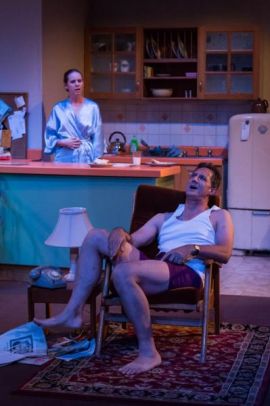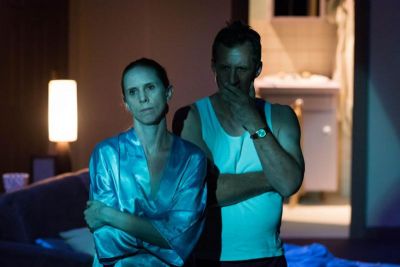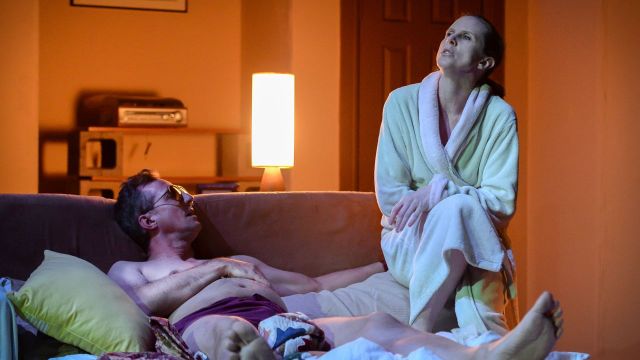Frankie and Johnny in the Clair de Lune
First staged Off -Broadway in 1987, Terrence McNally’s play has been nominated for Tony awards and adapted for the screen with Al Pacino and Michelle Pfeiffer in the title roles. It is a play not often found in community theatre repertoires as it involves some nudity and requires very sensitive acting and directing – both of which Castle Hill Players has managed to achieve. Though the action and the dialogue are very personal and revealing, the production is evocative, and the actors achieve a realism that is disarmingly natural.
The play brings together two lonely, middle-aged people who work in a city diner. Their first date ends up in the bedroom of Frankie’s little New York City apartment. Johnny is looking for stability and feels he has found his soul mate in Frankie. Frankie, with memories of an abusive former relationship still raw, is not so sure. In the early hours of this Sunday morning, with a full moon (Clair de Lune) shining on the bed, they unveil past joys and past hurts in a dialogue that is, once again, very personal and revealing.
 Director Peter Rhodes admits that he “has been waiting for seven years to share this beautiful play” – and this production shows that it has been worth the wait. In Leigh Scanlon and Dave Went he has cast two very committed, sensitive – and courageous – actors who have worked with him to find the essence of these damaged but determined characters. On a cluttered, realistic set where they have little room to escape the pulls and pushes of desire and apprehension, but room enough to explore their backgrounds – and show their culinary skill! – Scanlon and Went bring Frankie and Johnny to convincing life.
Director Peter Rhodes admits that he “has been waiting for seven years to share this beautiful play” – and this production shows that it has been worth the wait. In Leigh Scanlon and Dave Went he has cast two very committed, sensitive – and courageous – actors who have worked with him to find the essence of these damaged but determined characters. On a cluttered, realistic set where they have little room to escape the pulls and pushes of desire and apprehension, but room enough to explore their backgrounds – and show their culinary skill! – Scanlon and Went bring Frankie and Johnny to convincing life.
Scanlon finds the juxtaposition of strength and vulnerability in Frankie in a portrayal that is touching and believable. Her Frankie has steeled herself against being hurt. She won’t let the various walls she has built around herself be violated unless it is on her terms. However, as Johnny persists in his disarming declarations, she feels the walls start to crumble, and is torn between self-protection and the yearning for something more. Through tiny gestures, harsh, untypical reactions, abject apologies and gentle attempts at humour Scanlon’s Frankie is scarily natural and endearing.
So too is Dave Went’s Johnny. He is talkative, nervously brash, a little clumsy in this small, cluttered apartment, but determined to show Frankie that they will be good together. Her shyness about her body he covers with sincere, almost childlike admiration. Where she is reticent, he is confident – yet underneath this there is a similar vulnerability which Frankie senses, and eventually finds.
Together – and with Rhodes’ strong direction and belief in the play – these performers reach a little further than is usual for community theatre, finding the different dimensions of the characters and the underlying possibilities of their relationship.
 Peter Rhodes’ set and Sean Churchward’s lighting give them the perfect setting. On stage lamps, a working hot plate, ‘icebox’ and power point; a steam heater; old fashioned fuse box; a pull out window above the door to the hallway are indicative of the detail and care that has been taken. The sofa bed and coffee table fill the cramped living space and makeshift bookcases line the walls. This is every lived-in, New York style studio flat you have imagined. The moonlight shining on the bed – at times the only realisable light on the set – effectively evokes the intimacy of many of the scenes. Along with the glow of the two standard lamps, this makes the situation more realistic, and, cleverly, less confronting for both actors and audience alike.
Peter Rhodes’ set and Sean Churchward’s lighting give them the perfect setting. On stage lamps, a working hot plate, ‘icebox’ and power point; a steam heater; old fashioned fuse box; a pull out window above the door to the hallway are indicative of the detail and care that has been taken. The sofa bed and coffee table fill the cramped living space and makeshift bookcases line the walls. This is every lived-in, New York style studio flat you have imagined. The moonlight shining on the bed – at times the only realisable light on the set – effectively evokes the intimacy of many of the scenes. Along with the glow of the two standard lamps, this makes the situation more realistic, and, cleverly, less confronting for both actors and audience alike.
Bernard Teuben’s sound design makes the music an intricate part of the performance, as does Ken Bock’s recorded voice as Marley, the late night radio announcer.
This is a fine production that shows all that can be good about community theatre – commitment, creativity, caring direction, and courage.
Carol Wimmer
Photographer: Chris Lundie.
Subscribe to our E-Newsletter, buy our latest print edition or find a Performing Arts book at Book Nook.

